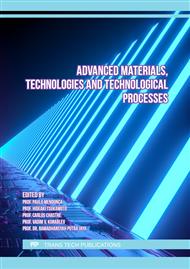p.3
p.11
p.19
p.29
p.35
p.41
p.49
p.55
Investigation of the Gradient Properties of Samples Obtained by Direct Laser Deposition from a Mixture of Ni/Ti Elemental Powders
Abstract:
The research of deposition of a nitinol sample in an equiatomic ratio from a powder mixture of nickel and titanium 55Ni-45Ti (in wt.%) is aimed at studying the heterogenicity of the chemical composition in the cross-section of a thin-walled and multilayer (bulk) cylindrical sample. The main task of the study was to determine the presence or absence of the chemical composition deviation from layer to layer, and mechanical properties. Analysis on an optical microscope, EDS analysis, and microhardness measurement, a thin-walled sample was studied. A chemical gradient was detected in the sample from the base along with its entire height. An increase in the content of the Ti element and a decrease of the Ni element was detected with an increase in the number of layers and the height of the sample, and a change in the microstructure and hardness were found. The increase in hardness from the base to the top point of the sample reaches 50%. X-ray phase analysis (XRD) showed the presence of NiTi phases in the martensitic and austenitic state, the side phases of NiTi2 in a thin-walled sample, and the presence of the Ni4Ti3 phase and the TiO2 oxide phase in a cylindrical bulk sample. The chemical composition of the cylindrical bulk sample agrees with the chemical composition of the mixture loaded into the powder feeder 55:45 Ni and Ti in wt. %. To indirectly determine the shape memory effect of the final alloy, mechanical tests were carried out for compression of cylindrical samples with subsequent heating, which confirmed the presence of the shape memory effect with a degree of reversible deformation of about 40%.
Info:
Periodical:
Pages:
3-10
Citation:
Online since:
March 2023
Authors:
Price:
Сopyright:
© 2023 Trans Tech Publications Ltd. All Rights Reserved
Share:
Citation:


